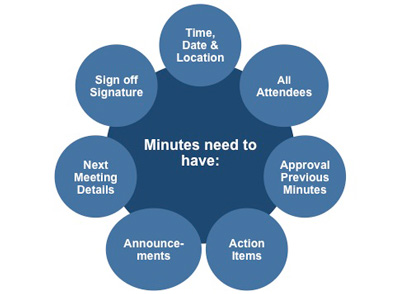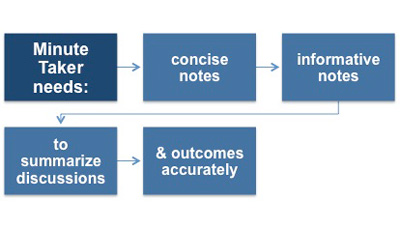Elements of Meeting Minutes
For meeting minutes to be an accurate reflection of what took place during a meeting there are certain elements that must be included in the electronic or written document.
 |
Many organizations use a standard template or have their own special format for keeping minutes. The order of the parts may vary but would typically include:
Heading
The name of the team or committee and the date, as well as the location, and time of the meeting.
Attendees
Must include the names of all those who came to the meeting, those who sent their apologies because they were unable to attend, and those who require copies of the minutes.
Approval of previous minutes
This is often the first heading below the housekeeping-type items so that it can be easily identified. Notes in this section will detail whether the minutes of the previous meeting were approved, what if any corrections were required, and list any outstanding actions and responsibilities.
Any individual who is unable to attend the meeting but has outstanding actions to be addressed from previous minutes is under an obligation to ensure either the Chair of the meeting or the minute taker is given an update on their action. This will ensure the smooth running of the meeting, as all appropriate information is available.
Action items
These items requiring action will include any unfinished business from the previous meeting as well as all current and new ones that now require attention.
The minutes will provide a report on each topic discussed at the meeting. For each item, note the subject of the discussion, the name of the person who led the discussion, and any decisions that may have been reached. Names of other individuals, third parties, or organizations will also be included where it adds clarity to the item.
Individuals who are unable to attend a particular meeting have an obligation to inform the Chair or minute taker of any progress they have made on their own actions.
Announcements
This section of the minutes reports on any announcements made by participants or those who sent their apologies, including proposed agenda items for the next meeting.
Next meeting
A note on where and when the next meeting will be held.
Signature line
The name of the person who prepared the minutes and the date they were submitted and agreed. Some organizations require more than one signatory for minutes of a legal nature, i.e. board meeting minutes.
A key area of consideration for the individual that is responsible for taking the minutes of the meeting is to keep the notes concise and informative so that they summarize the discussion and outcomes that took place.
 |
Some organizations have a prescribed outline of who is supposed to receive the minutes and a timeframe for when minutes must be circulated following a meeting. The nature and length of how long the minutes are supposed to be maintained on record will be unique to your organization.
This Meeting Minutes Tasks Checklist covers those tasks you need to complete before, during and after the meeting if you are taking the minutes. This Meeting Minutes Template provides a structured means to record all essential discussion details and findings.
The minutes also perform another function in that they assist the person responsible for producing the agenda, often the meeting chair, when finalizing the next meeting's agenda and help in allocating sufficient time to each agenda item to ensure a thorough discussion can take place. If any critical issues have been highlighted or outstanding actions are becoming a bottleneck for a project's progress these may need to be separate items on the agenda depending on their importance.
You may also be interested in:
Taking Meeting Minutes | Responsibilities of the Minute Taker | How to Take Meeting Minutes | Potential Problems When Taking Minutes | Meeting Minutes Checklist.



